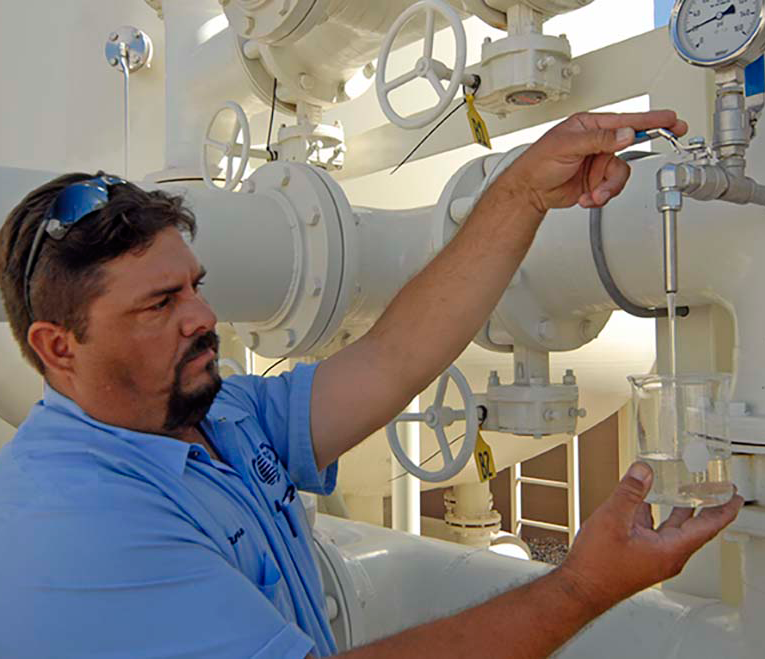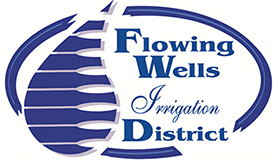
Flowing Wells Irrigation District
Annual Water Quality Report
for Calendar Year 2022
Este informe contiene informactión muy importante sobre el aqua usted bebe.
Tradúscalo ó hable con alguien que lo entienda bien.
PWSID# AZ04-10051
FWID is responsible for water quality throughout its system, ensuring that the water delivered is clean, safe and meets all local, state and federal drinking water health standards.
The Safe Drinking Water Act requires public water systems to comply with EPA and ADEQ drinking water regulations and, at established monitoring frequencies, District staff collects water samples from wells, storage tanks, sample stands and at entry points to the distribution system. Those samples are then taken to a state-licensed laboratory for analysis and test results are reported to the District and the Water Quality Division of the Arizona Department of Environmental Quality.
Contact Us
We want our valued customers to be informed about their water quality. If you would like to learn more about public participation or to attend any of our regularly scheduled meetings, please contact Richard M. Rubal at (520) 887-4192 or email rrubal@fwid.org for additional opportunity and meeting dates and times.
Drinking Water Sources
The sources of drinking water (both tap and bottled water) include rivers, lakes, streams, ponds, reservoirs, springs, and wells. As water travels over the surface of the land or through the ground, it dissolves naturally-occurring minerals, and in some cases, radioactive material, and can pickup substances resulting from the presence of animals or from human activity.
In order to ensure that tap water is safe to drink, EPA prescribes regulations which limit the amount of certain contaminants in water provided by public water systems. Food and Drug Administration (FDA) regulations establish limits for contaminants in bottled water which must provide the same protection for public health.
Our water source(s):
Flowing Wells Irrigation District has 7 wells that pump groundwater from the Upper Santa Cruz sub-basin

Drinking Water Contaminants
that may come from sewage treatment plants, septic
systems, agricultural livestock operations, and wildlife
Inorganic Contaminants: Such as salts and metals that
can be naturally-occurring or result from urban stormwater
runoff, industrial or domestic wastewater discharges, oil
and gas production, mining, or farming
Pesticides and Herbicides: Such as agriculture, urban
storm water runoff, and residential uses that may come
from a variety of sources.
volatile organic chemicals, which are by-products of industrial
processes and petroleum production, and also may come
from gas stations, urban storm water runoff, and septic
systems.
Radioactive Contaminants: That can be naturally occurring
or be the result of oil and gas production and mining
activities.
Vulnerable Population
Drinking water, including bottled water, may reasonably be expected to contain at least small amounts of some contaminants. The presence of contaminants does not necessarily indicate that water poses a health risk. Some people may be more vulnerable to contaminants in drinking water than the general population.
Immuno-compromised persons such as persons with cancer undergoing chemotherapy, persons who have undergone organ transplants, people with HIV-AIDS or other immune system disorders, some elderly, and infants can be particularly at risk from infections. These people should seek advice about drinking water from their health care providers.
For more information about contaminants and potential health effects, or to receive a copy of the U.S. Environmental Protection Agency (EPA) and the U.S. Centers for Disease Control (CDC) guidelines on appropriate means to lessen the risk of infection by Cryptosporidium and microbiological contaminants call the EPA Safe Drinking Water Hotline at 1-800-426-4791.
Source Water Assessment
This PWS did not receive a SWAP because the PWS was inactive at the time, the PWS did not exist, or the State failed to perform the assessment. Further source water assessment documentation can be obtained by contacting ADEQ.
Definitions
Treatment Technique (TT): A required process intended to reduce the level of a contaminant in drinking water
Level 1 Assessment: A study of the water system to identify
potential problems and determine (if possible) why total coliform bacteria was present
Level 2 Assessment: A very detailed study of the water
system to identify potential problems and determine (if
possible) why an E. coli MCL violation has occurred and/or
why total coliform bacteria was present
Action Level (AL): The concentration of a contaminant which,
if exceeded, triggers treatment, or other requirements
Maximum Contaminant Level (MCL): The highest level of a
contaminant that is allowed in drinking water
Maximum Contaminant Level Goal MCLG): The level of a
contaminant in drinking water below which there is no known
or expected risk to health
Maximum Residual Disinfectant Level (MRDL): The level of
disinfectant added for water treatment that may not be exceeded at the consumer’s tap
Maximum Residual Disinfectant Level Goal (MRDLG): The
level of disinfectant added for treatment at which no known or
anticipated adverse effect on health of persons would occur
Minimum Reporting Limit (MRL): The smallest measured concentration of a substance that can be reliably measured by a given analytical method
Millirems per year (MREM): A measure of radiation absorbed by the body
Not Applicable (NA): Sampling was not completed by regulation or was not required
Not Detected (ND or <): Not detectable at reporting limit
Nephelometric Turbidity Units (NTU): A measure of water clarity
Million fibers per liter (MFL)
Picocuries per liter (pCi/L): Measure of the radioactivity in water
ppm: Parts per million or Milligrams per liter (mg/L)
ppb: Parts per billion or Micrograms per liter (µg/L)
ppt: Parts per trillion or Nanograms per liter (ng/L)
ppq: Parts per quadrillion or Picograms per liter (pg/L)
ppm x 1000 = ppb
ppb x 1000 = ppt
ppt x 1000 = ppq
Lead Informational Statement:
Lead, in drinking water, is primarily from materials and components associated with service lines and home plumbing. If present, elevated levels of lead can cause serious health problems, especially for pregnant women and young children.
Flowing Wells Irrigation District is responsible for providing high quality drinking water, but cannot control the variety of materials used in plumbing components. When your water has been sitting for several hours, you can minimize the potential for lead exposure by flushing your tap for 30 seconds to 2 minutes before using water for drinking or cooking.
Information on lead in drinking water, testing methods, and steps you can take to minimize exposure is available from the
Safe Drinking Water Hotline or at www.epa.gov/safewater/lead.
Water Quality Data – Regulated Contaminants
| Disinfectants | MCL Violation Y or N |
Running Annual Average (RAA) |
Range of All Samples (Low-High) |
MRDL | MRDLG | Sample Month & Year |
Likely Source of Contamination |
| Chlorine (ppm) | N | 0.58 | 0.43-0.78 | 4 | 4 | 2022 | Water additive used to control microbes |
| Disinfection By-Products | MCL Violation Y or N |
Running Annual Average (RAA) OR Highest Level Detected |
Range of All Samples (Low-High) |
MCL | MCLG | Sample Month & Year |
Likely Source of Contamination |
| Total Trihalomethanes (TTHM (ppb) | N | 10.4 | 2.6-10.4 | 80 | N/A | 2022 | Byproduct of drinking water disinfection |
| Lead & Copper | MCL Violation Y or N |
90th Percentile | Number of Samples Exceeds AL |
AL | ALG | Sample Month & Year |
Likely Source of Contamination |
| Copper (ppm) | N | 0.098 | 0 | 1.3 | 1.3 | 7/2022 | Corrosion of household plumbing systems; erosion of natural deposits |
| Radionuclides | MCL Violation Y or N |
Running Annual Average (RAA) OR Highest Level Detected |
Range of All Samples (Low-High) |
MCL | MCLG | Sample Month & Year |
Likely Source of Contamination |
| Alpha Emitters (pCi/L) | N | 3.0 | 0-3.0 | 15 | 0 | 2/2022 | Erosion of natural deposits |

| Inorganic Chemicals (IOC) | MCL Violation Y or N |
Running Annual Average (RAA) OR Highest Level Detected |
Range of All Samples (Low-High) |
MCL | MCLG | Sample Month & Year |
Likely Source of Contamination |
| Arsenic1 (ppb) | N | 0.264 | 0.001 – 0.100 | 10 | 0 | 1/2021 | Erosion of natural deposits, runoff from orchards, runoff from glass and electronics production wastes |
| Barium (ppm) | N | 0.065 | 0.037 – 0.090 | 2 | 2 | 2/2019 | Discharge of drilling wastes; discharge from metal refineries; Erosion of natural deposits |
| Fluoride (ppm) | N | 0.25 | 0.16 – 0.50 | 4 | 4 | 2/2019 | Erosion of natural deposits; water additive which promotes strong teeth; discharge from fertilizer and aluminum factories |
| Nitrate2 (ppm) | N | 4.82 | 0.76 – 4.82 | 10 | 10 | 2/2019 | Runoff from fertilizer use; leaching from septic tanks,sewage; erosion of natural deposits |
| Sodium (ppm) | N | 128 | 31 – 310 | N/A | N/A | 1/2021 | Erosion of natural deposits |
1 Arsenic is a mineral known to cause cancer in humans at high concentration and is linked to other health effects, such as skin damage and circulatory problems. If arsenic is less than or equal to the MCL, your drinking water meets EPA’s standards. EPA’s standard balances the current understanding of arsenic’s possible health effects against the costs of removing arsenic from drinking water, and continues to research the health effects of low levels of arsenic.
2 Nitrate in drinking water at levels above 10 ppm is a health risk for infants of less than six months of age. High nitrate levels in drinking water can cause “blue baby syndrome.” Nitrate levels may rise quickly for short periods of time because of rainfall or agricultural activity. If you are caring for an infant, and detected nitrate levels are above 5 ppm, you should ask advice from your health care provider.
Flowing Wells Irrigation District had one violation in 2022, for late submission of a Public Notice forLead and Copper, due in July, 2022.
We corrected the violation by submitting the Public Notice on February 2, 2023.

If you would like a copy of this report mailed to you, please call, stop by, or email the office and we will be happy to get one to you or
click here for a downloadable copy (PDF format).